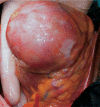Surgical treatment of cardiac hydatid disease in 13 patients
- PMID: 20401292
- PMCID: PMC2851433
Surgical treatment of cardiac hydatid disease in 13 patients
Abstract
Cardiac hydatidosis is an uncommon but potentially fatal disease. It remains endemic in developed and developing countries. Its clinical presentation ranges from an absence of symptoms to congestive heart failure or other life-threatening sequelae. Herein, we report our clinical experience with the disease. From 1991 through 2009, 7 male and 6 female patients (mean age, 36 +/- 18.3 yr; age range, 10-68 yr) underwent surgical treatment at our hospital for cardiac hydatid disease. Cardiac hydatidosis was established as a component of multiorgan echinococcosis in 8 patients, and it was diagnosed upon echocardiographic examination in the other 5 during investigation of their nonspecific symptoms. Hydatid cysts were found in the left ventricle (in 5 patients); the right ventricle (in 3); the interventricular septum (in 2); and the interatrial septum, right atrium, and left atrium (in 1 each). All 13 patients underwent sternotomy and surgery under cardiopulmonary bypass. No intraoperative rupture or operative death occurred. The only sequela was complete atrioventricular block that necessitated pacemaker implantation in a patient whose hydatid cyst had involved the basal interventricular septum. All patients underwent subsequent treatment with albendazole (400 mg/d). One patient experienced a recurrence 1 year postoperatively. We discuss our surgical approaches, the outcomes in our patients, and diagnostic and therapeutic recommendations.
Keywords: Albendazole; cardiac surgical procedures/methods; echinococcosis/diagnosis/surgery; heart diseases/parasitology/surgery; recurrence; treatment outcome.
Figures
References
-
- Shalaby RI, Rajendran U, Majeed OA, Shuhaiber H. Polyvisceral echinococcosis with involvement of the heart and chest wall: follow-up and review of literature. Ann Thorac Cardiovasc Surg 1999;5(4):248–53. - PubMed
-
- Kaplan M, Demirtas M, Cimen S, Ozler A. Cardiac hydatid cysts with intracavitary expansion. Ann Thorac Surg 2001;71 (5):1587–90. - PubMed
-
- Merdivenci A. Turkiye'de Kist Hidatik Hastaligi [hydatid cyst disease in Turkey] [in Turkish]. I.U.: Cerrahpasa Tip Fakultesi Yayinlari 1976;111.
-
- Erentug V, Bozbuga N, Kirali K, Mataraci I, Kaymaz C, Balkanay M, et al. Cardiac hydatid cysts: surgical treatment and results. J Card Surg 2004;19(4):358–60. - PubMed
-
- Guler M, Ipek G, Ogus T, Kirali K, Kutlu ST, Isik O, Yakut C. Cardiac echinococcosis mimicking a left ventricular aneurysm with intractable arrhythmia [in Turkish]. T Klin Kardiyoloji 1996;9:232–6.
MeSH terms
Substances
LinkOut - more resources
Full Text Sources
Medical




